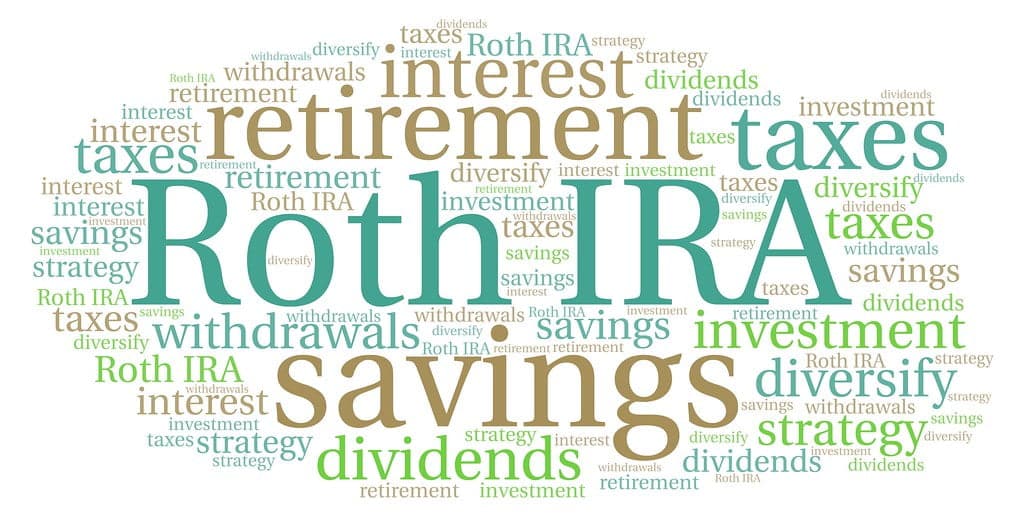
So what is a Roth IRA account? An IRA is a form of savings account specifically designed for retirement purposes. Contributions to a Roth IRA are deducted from your taxable income in the year they are made, making them a unique tax-favored retirement fund.
An individual’s investments to a Roth IRA, as well as any returns on those deposits, mature tax-free and may be taken tax-free after age 59 1/2, provided the plan has been open for a minimum of five years.
The quantity you put into your Roth IRA is taxed, but any cash you take out is not.

The main difference between a traditional IRA and a Roth IRA is the tax benefits of withdrawals. Contributing to a Roth IRA cannot be deducted from your taxable income, but withdrawals from the account will be processed without further tax liability.
MAJOR POINTS
Roth IRAs are a kind of IRA in which the investor pays taxes on contributions but receives tax-free returns.
Whenever you anticipate your marginal tax rate in retirement to be greater than it is today, a Roth IRA may be your better decision.
If your annual income is even more than $153,000 throughout 2023 (or $144,000 in 2022), you won’t be allowed to make a Roth IRA investment. During 2023, the ceiling for joint filers is $228,000 (up from $214,000 throughout 2022).
Occasionally, the maximum allowable contribution amount is adjusted. The cap will rise to $6,500 in 2023 (with an extra $1,000 for individuals over 50). A maximum of $7,000 per year might be contributed in 2022 if you were 50 or older.
A Roth IRA may be opened at almost any company, digital or offline. Most financial institutions share this view.
To what end would a Roth IRA serve?
A Roth IRA is a retirement account into which taxed income may be redirected. After that, it may expand tax-free until you collect money in retirement.
Funding options for a Roth IRA include:
- Investments that may be rolled over into a retirement plan
- Equal participation in IRAs
- Investing in frequently
- Conversions
- Transfers
Normal Roth IRA investments cannot be received in the kind of properties or securities and must instead be provided in currency (including money orders and checks).
The IRS sets the maximum yearly contribution to an IRA and is subject to periodic adjustments. Both Roth IRAs and traditional have the same maximum contribution limitations. You cannot exceed the maximum IRA contribution amount since it applies to all your IRAs.
The earnings on investments made inside a Roth IRA are exempt from income tax, just like those made within other eligible retirement plans. But, a Roth IRA has fewer limits than traditional IRAs.
Unlike traditional IRAs and 401(k)s, the account owner does not have to take RMDs from their Roth IRA over their entire life.
By contrast, contributions to traditional IRAs are often made using after-tax cash, meaning that the contributor receives a tax break but will be subject to income tax on the withdrawals made in retirement.
Allowed Roth IRA Contributions
After a Roth IRA contribution is made, the cash may be invested in a wide range of financial assets, from mutual funds, bonds, stocks, CDs, ETFs, and money market funds, to cryptocurrencies.
Remember that according to IRS regulations, investors cannot directly contribute cryptocurrencies to their Roth IRA. But, “Bitcoin IRAs” have recently emerged, making it possible to participate in cryptocurrencies via a retirement fund.
In addition to life insurance policies and derivative transactions, the IRS prohibits a long list of other investments from being held inside an Individual Retirement Account.
An (SDIRA) Roth Self-Directed IRA is a kind of Roth IRA where the owner, not the finance company, manages the account’s assets. With this, you may access a wide range of investing opportunities.
Creating a Roth IRA
A Roth IRA may only be opened at a finance company that has been granted IRA offering privileges by the IRS. The term “financial institutions” encompasses many businesses, from financial institutions to investment firms to credit unions and loan and savings organizations. Citizens often open Individual Retirement Accounts (IRAs) with financial advisors.
At any point in time, you may open a Roth IRA. Payments for a given tax year must be paid by the time the IRA holder files their taxes, typically April 15 of the next year.
In establishing an IRA, two important papers must be presented to the owner:
- The IRA disclosure statement.
- The IRA plan document and adoption agreement.
These define the relationship between the IRA holder and the IRA trustee and explain the policies and guidelines within which the Roth IRA will function. There is a wide range of quality across financial organizations.
There are IRA companies with a wide range of investment opportunities and those with fewer constraints. Your returns may be significantly affected depending on the fees associated with your Roth IRA. Selecting a Roth IRA custodian will depend on how comfortable you are with risk and what kinds of investments appeal to you.
A supplier with reduced trading expenses is preferable if you wish to be an active trader and make many deals.
Inactivity Fee
Some service providers may even impose an inactivity fee if you don’t access your funds for an extended period. Depending on your investing goals, different brokers may provide a wider selection of stocks and ETFs.
Take note of the prerequisites for opening that particular kind of account. Certain service providers need a larger opening amount in your account before you can begin making withdrawals.
Check whether your Roth IRA comes with any other financial services from the same institution if you want to remain with them.
Check to see if the financial institution or investment house you currently have an account with offers any IRA fee savings if you’re considering starting a Roth IRA there.
Generally, only standard IRAs (either Roth or traditional) are available through IRA providers. For a self-directed IRA, which may hold investments other than bonds, mutual funds, stocks, and ETFs, you’ll need a certified IRA custodian that caters to this niche. An example of this is Gold IRA companies.
Should I Invest in a Roth IRA?
Keep advised that the same types of insurance do not cover Individual Retirement Accounts (IRAs) as other bank accounts. In this way, IRAs have fewer protections than other types of retirement savings.
Traditional and Roth IRA balances are pooled together and insured by the FDIC for up to $250k rather than the separate limits that were previously applied.
The Saver’s Tax Credit
The IRS limits how much and what kinds of assets may be put into a Roth IRA. You can only fund a Roth IRA with money you’ve already earned. In addition, taxed alimony earned from a divorce case completed previous to December 31, 2018, is eligible for a contribution, as is any funds raised as child support, alimony, or in a settlement from a marriage separation.
Citizens cannot put more money into their IRA in a given year than they brought in that year. And as we’ve already established, there’s no tax break for the donation. However, based on their earnings and other factors, they could be eligible for a Saver’s Tax Credit of 50%, 20%, 10%, 20%, or 50% of the investment.
Traditional IRA vs. Roth IRA
A worker’s tax bracket, projected retirement tax rate, and preferences all factor into whether a Roth IRA vs. Traditional IRA is the better option. Because the amount of taxes evaded in retirement is more than the taxes paid now, the Roth IRA could be more beneficial for those who anticipate being in a top tax bracket upon retirement. So, a Roth IRA could be advantageous for youthful and low-income employees.
An individual retirement account (IRA) allows you to take advantage of compound growth, which grows your money by investing it and reinvesting the income it earns. If tax-free retirement earnings are more important to you than a current tax deduction, you may create a
Roth IRA instead of a traditional IRA.
A Roth IRA allows you to withdraw money tax-free in the future, regardless of your expected tax rate.
Certainly not the most awful suggestion ever. If you don’t want the funds you put into a Roth IRA during retirement, you may let it grow eternally and then transfer it to your children tax-free.
The recipient of an inherited IRA should receive distributions, but they may delay taxes for up to ten years or, in rare situations, for the rest of their lives, provided they meet certain requirements.
However, recipients of funds from a traditional IRA must pay taxes on those funds. If a married couple inherits an IRA, they may transfer the funds to their own IRA and delay payouts until age 73.
Occasionally people join or change to a Roth IRA if they expect taxes to go up in the future and wish to preserve their after-tax investment gains for as long as possible.
To avoid taking obligatory minimum withdrawals beginning at age 73, bosses and other handsomely paid workers who are eligible to subscribe to a Roth retirement account via their companies may do so by rolling their Roth 401(k)s into Roth IRAs tax-free.
